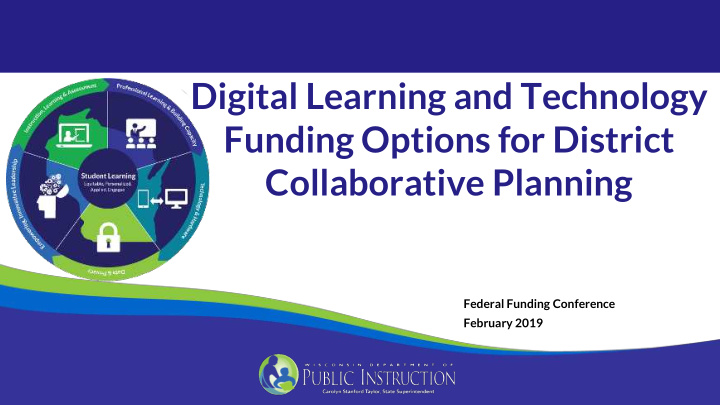



Digital Learning and Technology Funding Options for District Collaborative Planning Federal Funding Conference February 2019
Agenda Introductions ● Collaborative Leadership Team Budgeting Strategies ● DPI Finance Digital Learning Budget Updates ● Future Ready Elements of Budgets ● “NEW” DPI web resources - integrated funding options ●
Who is in the Audience today? ● Superintendent ● Teaching and Learning ● Business Office and Financial ● Instructional Technology ● Student Services ● Building Principals
The Wisconsin Vision Every Child a Graduate, College & Career Ready EVERY Student is: • Academically Prepared • Socially Competent • Emotionally Competent Demonstrated through: • Knowledge • Skills • Habits
Educa Educational tional Equi Equity ty Educational equity means that every student has access to the educational resources and rigor they n eed at the right moment in their education across race, gender, ethnicity, language, disability, sexual orientation, family background and/or https://dpi.wi.gov/statesupt/every-child-graduate family income.
Embrace “Equity” of Access by Providing Inclusive Learning Opportunities “One of the benefits of well -designed interactive programs is that they can allow all students to see and explore concepts from different angles using a variety of representation.” Using Technology to Support At- Risk Students’ Learning Linda Darling Hammond, et al. Alliance for Excellence Education Promoting Excellence for All Wisconsin DP I
Wisconsin Digital Learning Plan with Elements of Future Ready New ITL Standards https://dpi.wi.gov/imt/it-literacy-standards https://dpi.wi.gov/digital-learning
Vision for collaborative budgeting ● WI DPI resources on integrated funding sources ● National exemplars (WI exemplars coming soon) ● Wisconsin Digital Learning Plan/Future Ready alignment for best ● instructional practices Literature review on digital learning budgeting ● https://dpi.wi.gov/digital-learning/budgeting
Empowering, Innovative Leadership A digital conversion requires leadership at all levels that is shared, collaborative, innovative and that is communicated to all stakeholders. The Future Ready Framework collaborative leadership elements include: A Shared, Forward-Thinking Vision for Digital Learning ● A Culture of Collaboration, Innovation, Capacity Building, and Empowerment ● High Expectations for Evidence-Based Transformations to Digital Learning ● Transformative, Coherent Thinking, Planning, Policies, and Implementation ●
Element 1: Efficiency and Cost Savings ● Element 2: Alignment to District and School Plans ● Element 3: Consistent Funding Streams ● Element 4: Learning Return on Investment ● https://dpi.wi.gov/digital-learning/budgeting
Audience Questions Any questions about the purpose and basics of why digital learning budgeting is a collaborative district process? Any barriers you can identify?
Three Steps for Planning Process for collaborative leadership teams: Investigate - identify the why for ● instructional programming Plan - aligning your fund sources ● Implement - sustaining your plan ●
DPI School Finance Technology Updates Why did DPI update the Technology WUFAR codes? more detailed object codes ● identified examples under functions to assist districts ● alignment to federal guidelines ● December 2018 Technology WUFAR Updates
Instruction, Learning & Assessment Future College and Career Ready students deserve digital access to online, blended and face-to-face curricula that is standards-based and personalized to meet their academic needs.The Future Ready elements that comprise this Gear are as follows: 21st Century Skills/Deeper Learning ● Personalized Learning ● Collaborative, Relevant, and Applied Learning ● Leveraging Technology ● Assessment — Analytics Inform Instruction ●
Positive Imp Positive Impacts for Districts acts for Districts Opportunity for collaborative budgeting discussions ● Alignment to federal purchasing codes ● More details for districts ● Integrated funding options ●
Element 1: Efficiency and Cost Savings ● Element 2: Alignment to District and School Plans ● Element 3: Consistent Funding Streams ● Element 4: Learning Return on Investment ● https://dpi.wi.gov/digital-learning/budgeting
Integrated federal ESSA fund sources: Title programs, grants, E-rate ● Integrated state fund sources : TEACH, GPR programs, grants, Common ● School Funds Local funding options including foundations, local revenues and community ● partnerships, referendum focus areas, district instructional initiatives Consortia purchasing options and state digital content resources ● Wisconsin Digital Learning Collaborative ● https://dpi.wi.gov/digital-learning/budgeting
“NEW” Title IVA Allowable Expenses (4109) • Supporting high quality professional learning • Building technological capacity and infrastructure • Carrying out innovative blended learning projects • Rural, high-quality digital learning opportunities • Delivering specialized or rigorous academic courses * Integrated Planning and Programming with Title IVA Safe and Healthy Schools (4108) and Well Rounded Instruction (4109) https://dpi.wi.gov/titleiva
Walk through Digital Learning Budget Guide https://dpi.wi.gov/digital-learning/budgeting
Future Ready to Support Local Planning Tool Set Create your collaborative leadership team ● Create your instructional student vision of learning to identify the supports ● of professional learning, infrastructure and privacy practices Leverage the strategic planning and school improvement toolset ● District Future Ready dashboard for to address “opportunity gaps” ● (dashboard framework, funding components and staffing support) Use the best practices and innovative ideas section to help identify solutions ●
WI Digital Learning Plan – Future Ready Elements
Questions I
DPI Contacts for Digital Learning Budgeting Janice D. Mertes Assistant Director - Content and Learning/Digital Learning @WisDPITech janice.mertes@dpi.wi.gov Roger Kordus Consultant – School Financial Services Team roger.kordus@dpi.wi.gov
Recommend
More recommend